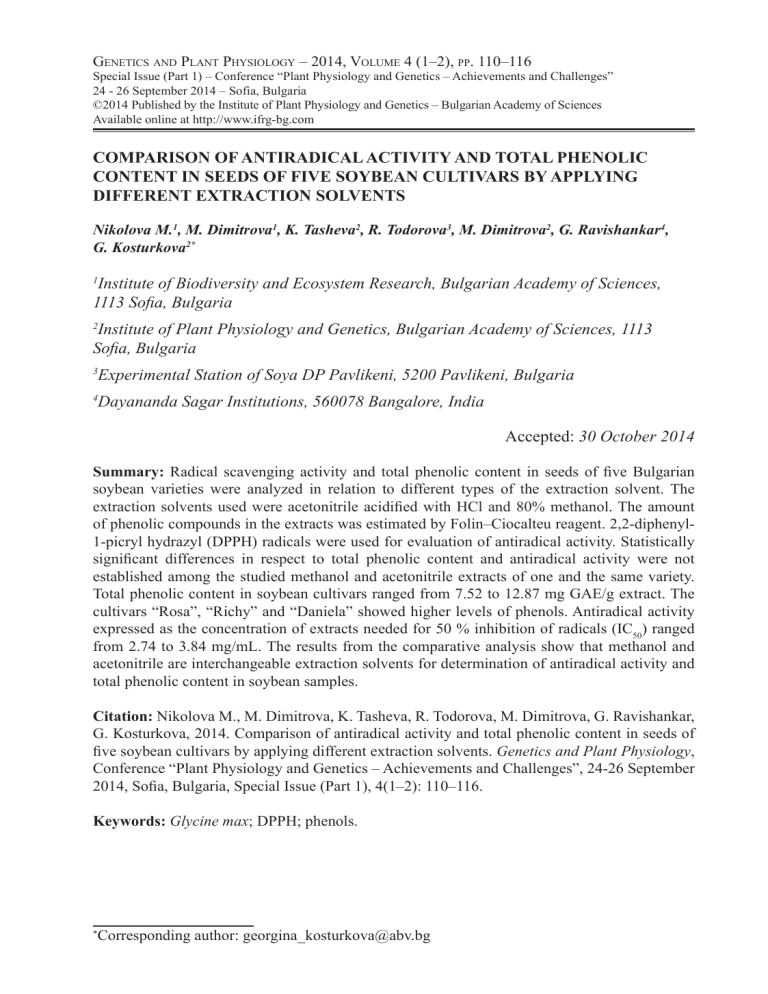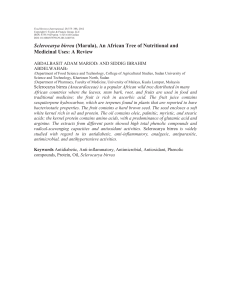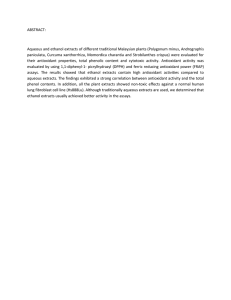30 October 2014 COMPARISON OF ANTIRADICAL

G enetics and
P lant
P hysioloGy
– 2014, V olume
4 (1–2),
PP
. 110–116
Special Issue (Part 1) – Conference “Plant Physiology and Genetics – Achievements and Challenges”
24 - 26 September 2014 – Sofia, Bulgaria
©2014 Published by the Institute of Plant Physiology and Genetics – Bulgarian Academy of Sciences
Available online at http://www.ifrg-bg.com
COMPARISON OF ANTIRADICAL ACTIVITY AND TOTAL PHENOLIC
CONTENT IN SEEDS OF FIVE SOYBEAN CULTIVARS BY APPLYING
DIFFERENT EXTRACTION SOLVENTS
Nikolova M.
1 , M. Dimitrova 1 , K. Tasheva 2 , R. Todorova 3 , M. Dimitrova 2 , G. Ravishankar 4 ,
G. Kosturkova 2*
1 Institute of Biodiversity and Ecosystem Research, Bulgarian Academy of Sciences,
1113 Sofia, Bulgaria
2 Institute of Plant Physiology and Genetics, Bulgarian Academy of Sciences, 1113
Sofia, Bulgaria
3 Experimental Station of Soya DP Pavlikeni, 5200 Pavlikeni, Bulgaria
4 Dayananda Sagar Institutions, 560078 Bangalore, India
Accepted: 30 October 2014
Summary: Radical scavenging activity and total phenolic content in seeds of five Bulgarian soybean varieties were analyzed in relation to different types of the extraction solvent. The extraction solvents used were acetonitrile acidified with HCl and 80% methanol.
The amount of phenolic compounds in the extracts was estimated by Folin–Ciocalteu reagent. 2,2-diphenyl-
1-picryl hydrazyl (DPPH) radicals were used for evaluation of antiradical activity. Statistically significant differences in respect to total phenolic content and antiradical activity were not established among the studied methanol and acetonitrile extracts of one and the same variety.
Total phenolic content in soybean cultivars ranged from 7.52 to 12.87 mg GAE/g extract. The cultivars “Rosa”, “Richy” and “Daniela” showed higher levels of phenols. Antiradical activity expressed as the concentration of extracts needed for 50 % inhibition of radicals (IC
50
) ranged from 2.74 to 3.84 mg/mL. The results from the comparative analysis show that methanol and acetonitrile are interchangeable extraction solvents for determination of antiradical activity and total phenolic content in soybean samples.
Citation: Nikolova M., M. Dimitrova, K. Tasheva, R. Todorova, M. Dimitrova, G. Ravishankar,
G. Kosturkova, 2014. Comparison of antiradical activity and total phenolic content in seeds of five soybean cultivars by applying different extraction solvents. Genetics and Plant Physiology ,
Conference “Plant Physiology and Genetics – Achievements and Challenges”, 24-26 September
2014, Sofia, Bulgaria, Special Issue (Part 1), 4(1–2): 110–116.
Keywords: Glycine max ; DPPH; phenols.
* Corresponding author: georgina_kosturkova@abv.bg
Comparison of antiradical activity and total phenolic content of soybean seeds 111
INTRODUCTION
Soybean ( Glycine max L. Merr.) is an annual plant and one of the most important grain legumes in the world.
The species is native to East Asia but widely cultivated in the world because it is globally important source of proteins, oils and secondary metabolites – phenolic compounds and isoflavonoids, such as glycitein, genistein and daidzein possessing antioxidant activity (Fritz et al., 2003; Malenčić et al., 2008;
Sammour, 2011).
A widely accepted tool for estimation of antioxidant capacity of plant extracts is the DPPH (1,1-diphenyl-2picrylhydrazyl) method. Alcohol solution of DPPH is purple colored, which after being reduced by an antioxidant, turns into a yellow-colored product.
The DPPH assay is considered a valid accurate, easy and economic method which provides first hand information on the overall antioxidant capacity of the test system
( Marinova and Batchvarov, 2011; Kedare and Singh, 2011). The antioxidant potential of soybean products and their phenolic content has been extensively evaluated by DPPH assay and Folin–
Ciocalteu reagent, respectively (Kim et al., 2006; Malenčić et al., 2007; Dajanta et al., 2011 ).
In Bulgaria, scientific and applied research in soybean production is concentrated at the Experimental Station of Soya, Pavlikeni. A series of elite soybean varieties with improved yield, nutrition qualities, biotic and abiotic stress tolerance has been released.
Seeds of some of these varieties were analyzed previously for their content of phytoestrogen compounds (Sakthivelu et al., 2008). The present biochemical work is an extension to our former analysis using several new cultivars.
The aim of this study was to compare the efficiency of two extraction solvents for estimation of the total phenolic content and antioxidant activity of soybean seeds. The comparative study was performed with five genotypes cultivated in Bulgaria.
MATERIALS AND METHODS
Material
The study was performed with
Bulgarian soybean varieties: “Richy”,
“Rosa”, “Srebrina” and “Daniela” and the American variety “Hodson” (world standard) provided by the Experimental
Station of Soya DP Pavlikeni, Bulgaria.
Preparation of extracts
Acetonitrile (ACN) extracts . The powdered soybean seeds (2 g) were mixed with 2 mL 0.1 N HCl and 10 mL acetonitrile in a 125-mL flask and stirred for 2 h at room temperature. The solution was filtered and dried under vacuum at a temperature below 30°C (Kim et al.,
2005).
Methanol extracts.
The powdered soybean samples (2 g) were extracted with
80% methanol by maceration at room temperature for 24 h. After evaporation of the solvent the crude extract was subjected to subsequent analysis.
Determination of total phenolic content
Total phenolic content of the methanol and acetonitrile extracts was determined by methods using Folin-
Ciocalteu reagent and gallic acid as a
G enetics
& P lant
P hysioloGy
2014 vol
. 4 (1–2) Special Issue (Part 1)
112 Nikolova et al.
standard ( Nićiforović et al., 2010). Plant extracts were diluted to a concentration of
5 mg mL –1 , and aliquots of 0.4 mL were mixed with 2.0 mL of Folin–Ciocalteu reagent (beforehand diluted 10-fold with distilled water) and 1.6 mL of Na
2
CO activity using the following equation:
DPPH antiradical scavenging capacity
]
3
(7.5 %). After 1 h at room temperature, the absorbance of the samples was measured spectrophotometrically at
Determination of DPPH radicalscavenging activity
The effect of methanolic extract and acetonitrile on DPPH radicals was estimated according to Stanojević et al. (2009) with minor modifications.
Different concentrations of plant extract in methanol (1, 2, 5, 10 and 20 mg/mL) were added at an equal volume (2.5 mL) to methanol solution of DPPH (0.3 mM,
1 mL). After 30 min at room temperature, the Ab values were measured at 517 nm on a spectrophotometer (Jenway 6320D) and converted into percentage antioxidant
(%) = [1- (Ab sample
– Ab blank
) / Ab control x100
Methanol (1.0 mL) plus plant extract solution (2.5 mL) was used as a blank, while DPPH solution plus methanol was
765 nm versus a blank sample. Total phenols were determined as gallic acid equivalents (mg GA per g of extract) by the following formula:
C = c × V /m where C is total content of phenolic compounds (mg g –1 plant extract) in
GAE; c is the concentration of gallic acid established from the calibration curve
(mg mL –1 ); V is the volume of the extract
(mL); m is the weight (g) of the pure plant methanolic extract. used as a control. The IC
50
values were calculated using Software Prizm 3.00.
Statistical analysis
All assays were performed in three independent experiments and are presented as mean value ± standard deviation (SD).
Statistical analysis was carried out using
Excel. Significance levels were defined at p<0.05 as analyzed by t -test.
RESULTS AND DISCUSSION
DPPH radical scavenging activity
Two types of extracts - methanol
(ME) and acetonitrile (AE) from five soybean varieties were evaluated for their antiradical potential using the DPPH method. The results are presented as IC
50 values (mg/mL) - extract concentration providing 50% inhibition of the DPPH solution. The antiradical activity of the studied extracts ranged from 2.74 mg/mL to 3.84 mg/mL. Differences between the methanol and acetonitrile extracts were detected but they were not statistically significant (p<0.05) even for cultivars
“Hodson” and “Daniela” where the differences between the two extractions were greatest. The highest antiradical activity was observed in the acetonitrile extract (AE) of cv. “Srebrina” followed by very similar values of the extracts of varieties “Richy” (AE and ME),
“Hodson” (ME) and “Daniela” (ME).
The lowest antiradical activity exhibited the acetonitrile extract of cv. “Daniela”
(Fig. 1). The obtained values were close to those reported in the literature for soybean with black and yellow kernel coat and cooked soybean (Haiwei, 2010;
Dajanta et al., 2011; Žilić et al., 2011;
Sefatie et al., 2013). The obtained data
G enetics
& P lant
P hysioloGy
2014 vol
. 4 (1–2) Special Issue (Part 1)
Comparison of antiradical activity and total phenolic content of soybean seeds 113
Figure 1. Antiradical activity of extracts from different soybean cultivars.
for antiradical properties of the studied cultivars are better compared with those reported for Croatian soybean seed cultivars and a Thai soybean ( al., 2011; Samruan et al., 2012).
Mujić et
Total phenolic content
The results on total phenolic content determination in the methanol and acetonitrile extracts of the studied cultivars evaluated by the Folin -
Ciocalteu method, are presented in Fig.
2. The phenolic content of the analyzed extracts ranged between 7.52 and 12.87 mg GAE/g extract. Differences between the methanol and acetonitrile extracts of one cultivar were observed but they were not statistically significant (p<0.05). In most cases, the methanol extract had slightly higher content of phenols in comparison to acetonitrile of one and the same cultivar, with the exception of the extracts of cv. “Srebrina”. The highest content of phenols was found in the methanol extract of cv. “Rosa” and the lowest in the methanol extract of cv.
“Srebrina”. The obtained results on total phenolic content of the analyzed cultivars were in the range of the values reported for other soybean cultivars where the reported values varied from 6.4 to 81.7 mg GAE/g extract (Pracas et al., 2007).
Correlation between total phenolic content and antiradical activity
A positive correlation between total phenolic content and antiradical activity was found in the extracts (ME and AE) of cultivars “Hodson” and “Daniela”.
Although there were significant differences in the phenolic content between metanol and acetonitrile extracts of cv. “Richy” differences in antiradical activity were not established. The methanol extract of cv. “Rosa” had high phenolic content, but showed low antiradical activity. The
G enetics
& P lant
P hysioloGy
2014 vol
. 4 (1–2) Special Issue (Part 1)
114 Nikolova et al.
Figure 2. Total phenolic content of extracts from different soybean cultivars.
lack of positive correlation between total phenolic content and antiradical activity was detected in the extracts (ME and AE) of cv. “Srebrina”.
Although most of the authors have found a positive correlation between the content of phenolic compounds and antioxidant activity in soybean samples
(Kim et al., 2006; Malenčić et al., 2007) the cases where there is not such a dependence are not an exception (Ried et al., 2007; Dajanta et al., 2011; Carson et al.,
2012). The absence of such a correlation has been explained with the presence of some other antioxidant compounds such as oligoproteins, free amino acids, peptides and melanoidins (Carson et al.,
2012; Dajanta et al., 2011). On the other hand, data are available showing that isoflavonoid a glycones (i.e., daidzein and genistein) can be inactive substrates in the radical scavenging assay (Dajanta et al.,
2011).
CONCLUSION
Statistically significant differences
(p<0.05) with respect to total phenolic content and antiradical activity were not established among the studied methanol and acetonitrile extracts of one and the same soybean variety.
This result shows that methanol and acetonitrile are equally effective in the analysis of total phenolic content and antiradical activity of soybean samples. Both solvents are interchangeable in the analysis of antiradical activity and total phenolic content. However, low cost methanol could be preferable for large scale analyses.
AKNOWLEDGEMENTS
The research was funded by the
Bulgarian NSF under the Intergovernmental
Program for S&T between Bulgaria and
India (projects DNTS-01/2 2013-2016).
G enetics
& P lant
P hysioloGy
2014 vol
. 4 (1–2) Special Issue (Part 1)
Comparison of antiradical activity and total phenolic content of soybean seeds 115
REFERENCES
Carson LC, JH Freeman, K Zhou, GE
Welbaum, 2012. Antioxidant capacity and isoflavone content in seeds of five edamame ( Glycine max L. Merrill) cultivars. Proc Fla State Hort Soc,
125: 169–173.
Dajanta K, A Apichartsrangkoon, E
Chukeatirote, 2011. Antioxidant properties and total phenolics of thua nao (a Thai fermented soybean) as affected by Bacillus -fermentation. J
Microbial Biochem Technol , 3: 056–
059.
Haiwei R, 2010. Antioxidant and free radical-scavenging activities of black soybean peptides (BSP) . Int J Agric &
Biol Eng, 3(2): 64–69.
Fritz K L, CM Seppanen, MS Kurzer, AS
Csallany, 2003.The in vivo antioxidant activity of soybean isoflavones in human subjects. Nutr Res, 23: 479–
487.
Kim JA, WS Jung, SC Chun, CY Yu,·KH
Ma, JG Gwag, IM Chung, 2006.
A correlation between the level of phenolic compounds and the antioxidant capacity in cooked-withrice and vegetable soybean ( Glycine max L.) varieties.
Eur Food Res
Technol, 224:259–270.
Kim SH, WS Jung , JK Ahn, IM Chung,
2005. Analysis of isoflavone concentration and composition in soybean Glycine max (L.) seeds between the cropping year and storage for 3 years. Eur Food Res Technol,
220: 207–214.
Kedare SB , RP Singh, 2011. Genesis and development of DPPH method of antioxidant assay. J Food Sci Technol,
48(4):412–422.
Malenčić D, M Popović , J Miladinović ,
2007.
Phenolic content and antioxidant properties of soybean ( Glycine max
(L.) Merr.) seeds. Molecules, 12:
576–581.
Malenčić D, Z Maksimović, M Popović,
J Miladinović, 2008. Polyphenol contents and antioxidant activity of soybean seed extracts. Bioresource
Technol, 99: 6688–6691.
Marinova G, V Batchvarov, 2011.
Evaluation of the methods for determination of the free radical scavenging activity by DPPH. Bulg J
Agric Sci, 17(1): 11–24.
Mujić I., E Šertović, S Jokić, Z Sarić, V
Alibabić, S Vidović, J Živković, 2011 .
Isoflavone content and antioxidant properties of soybean seeds.
Croat J
Food Sci Technol, 3: 16–20.
Nićiforović N, V Mihailović, P Masković, S
Solujić, A Stojković, DP Muratspahić,
2010. Antioxidant activity of selected plant species; potential new sources of natural antioxidants. Food Chem
Toxicol, 48: 3125–30.
Prakash D, G Upadhyay, BN Singh, HB
Singh, 2007. Antioxidant and free radical-scavenging activities of seeds and agri-wastes of some varieties of soybean (Glycine max). Food Chem,
104: 783–790.
Riedl KM, JH Lee, M Renita, S Martin,
S Schwartz, J Yvodovotz, 2007.
Isoflavone profiles, phenol content, and antioxidant activity of soybean seeds as influenced by cultivar and growing location in Ohio.
J Sci Food
Agric, 87: 1197–1206.
Sakthivelu G, MK Devi, P Giridhar, T
Rajasekaran, G Ravishankar, MT
Nikolova, G Angelov, RM Todorova,
G Kustorkova, 2008. Isoflavone
G enetics
& P lant
P hysioloGy
2014 vol
. 4 (1–2) Special Issue (Part 1)
116 Nikolova et al.
composition, phenol content and antioxidant activity of soybean seeds from India and Bulgaria . J Agric Food
Chem, 56(6): 2090–2095.
Sammour RH, 2011. Genetic diversity and allele mining in soybean germplasm.
In: Soybean - genetics and novel techniques for yield enhancement, Ed.
D Krezhova, InTech, Croatia, 3–22.
Samruan W, A Oonsivilai, R Oonsivilai,
2012. Soybean and fermented soybean extract antioxidant activities.
World Acad Sci Eng Technol, 72:
1315–1318.
Sefatie RS, T Fatoumata, K Eric, YH Shi,
L Guo-Wei, 2013. In Vitro Antioxidant
Activities of Protein Hydrolysate from
Germinated Black Soybean ( Glycine max L.).
Adv J Food Sci Technol,
5(4): 453–459.
Stanojevi ć L, M Stankovi ć, V Nikoli ć,
L Nikoli ć, D Risti ć, Č anadanovic-
Brunet J, Tumbas V. 2009. Antioxidant activity and total phenolic and flavonoid contents of Hieracium pilosella L. extracts. Sensors, 9:
5702–5714.
Žilić S, V H adži -T asković Šukalović, V
M aksimović , M M aksimović, Z Basić ,
V P erić , J D ragišićM aksimović,
2011. Antioxidant properties of soybean with black and yellow kernel coat. In: Proc 46th Croatian and 6th International Symposium on
Agriculture. Opatija. Croatia, Ed. M.
Pospišil, 686–689.
G enetics
& P lant
P hysioloGy
2014 vol
. 4 (1–2) Special Issue (Part 1)



